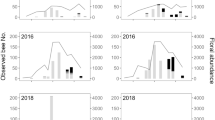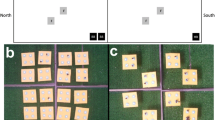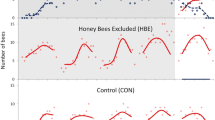Abstract
To examine whether the interaction between bumblebees, Bombus ignitus, reduces their foraging area, we conducted bee-removal experiments in a net cage. In the cage, we set potted Salvia farinacea plants, allowed bumblebees to forage freely on those plants, and followed their plant-to-plant movements to identify a bee with a relatively small foraging area. We then removed all the other foraging bees, except for the bee with a small foraging area, and observed the change of the foraging area of the focal bee under conditions of no interaction with other bees. After the removal of the other bees, all five bees tested enlarged their foraging areas, suggesting that the interaction between bees is an important determinant of their foraging areas. The result also means that bumblebees are able to adjust their foraging areas in response to other foragers, indicating the necessity for future studies to clarify what cues bees use to interact with other bees. Moreover, after the removal treatments, all five bees showed temporary increases in the number of flower probes per plant. This can be explained by their optimal foraging according to the “old” average intake rate for the plant population and by the delayed changes in response to the “new” high average energy intake rate after the bee-removal treatments.



Similar content being viewed by others
References
Charnov EL (1976) Optimal foraging, the marginal value theorem. Theor Popul Biol 9:129–136
Chittka L, Dyer AG, Bock F, Dornhaus A (2003) Bees trade off foraging speed for accuracy. Nature 424:388
Comba L (1999) Patch use by bumblebees (Hymenoptera Apidae): temperature, wind, flower density and traplining. Ethol Ecol Evol 11:243–264
Cresswell JE (1990) How and why do nectar-foraging bumblebees initiate movements between inflorescences of wild bergamot Monarda fistulosa (Lamiaceae)? Oecologia 82:450–460
Gill FB (1988) Trapline foraging by hermit hummingbirds: competition for an undefended renewable resource. Ecology 69:1933–1942
Giurfa M (1993) The repellent scent-mark of the honeybee Apis mellifera ligustica and its role as communication cue during foraging. Insectes Soc 40:59–67
Goulson D, Chapman JW, Hughes WOH (2001) Discrimination of unrewarding flowers by bees; direct detection of rewards and use of repellent scent marks. J Insect Behav 14:669–678
Heinrich B (1976) The foraging specializations of individual bumblebees. Ecol Monogr 46:105–128
Hodges CM (1985) Bumble bee Bombus appositus foraging the threshold departure rule. Ecology 66:179–187
Hurlbert SH (1971) The nonconcept of species diversity: a critique and alternative parameters. Ecology 52:577–586
Janzen DH (1971) Euglossine bees as long-distance pollinator of tropical plants. Science 171:203–205
Krebs CJ (1999) Ecological methodology, 2nd edn. Cummings, Menlo Park, Calif
Makino TT, Sakai S (2004) Findings on spatial foraging patterns of bumblebees (Bombus ignitus) from a bee-tracking experiment in a net cage. Behav Ecol Sociobiol 56:155–163
Pappers SM, de JTJ, Klinkhamer PGL, Meelis E (1999) Effects of nectar content on the number of bumblebee approaches and the length of visitation sequences in Echium vulgare (Boraginaceae). Oikos 87:580–586
Possingham HP (1989) The distribution and abundance of resources encountered by a forager. Am Nat 133:42–60
Schmitt U, Lubke G, Francke W (1991) Tarsal secretion marks food sources in bumblebees (Hymenoptera: Apidae). Chemoecology 2:35–40
Simberloff D (1972) Properties of rarefaction diversity measurement. Am Nat 106:414–418
Stout JC, Goulson D (2001) The use of conspecific and interspecific scent marks by foraging bumblebees and honeybees. Anim Behav 62:183–189
Thomson JD (1988) Effects of variation in inflorescence size and floral rewards on the visitation rates of traplining pollinators of Aralia hispida. Evol Ecol 2:65–76
Thomson JD, Maddison WP, Plowright RC (1982) Behavior of bumble bee pollinators of Aralia hispida Vent. (Araliaceae). Oecologia 54:326–336
Thomson JD, Peterson SC, Harder LD (1987) Response of traplining bumble bees to competition experiments shifts in feeding location and efficiency. Oecologia 71:295–300
Thomson JD, Slatkin M, Thomson BA (1997) Trapline foraging by bumble bees. II. Definition and detection from sequence data. Behav Ecol 8:199–210
Williams NM, Thomson JD (1998) Trapline foraging by bumble bees. III. Temporal patterns of visitation and foraging success at single plants. Behav Ecol 9:612–621
Acknowledgements
We would like to thank Tomoyuki Itagaki, Yuko Yasumura, Takafumi Fukuda, Ayaka Ikezoe, Masayoshi Tamura, and Hiroko Kumano for their help in data collection. We are also grateful to two anonymous reviewers for valuable advice, Ken-ichi Sato, Akiko Sakai, Shimpei Oikawa, Kunihiko Takahashi, Hisashi Tsujisawa, Yasuko C. Miyake, and Tomoyuki Hiraga for their assistance in construction/removal of the cage, and Masahiro Mitsuhata for providing us with a facility for use of bumblebee colonies. The experiments conducted for this study comply with current Japanese law.
Author information
Authors and Affiliations
Corresponding author
Additional information
Communicated by M. Giurfa
Rights and permissions
About this article
Cite this article
Makino, T.T., Sakai, S. Does interaction between bumblebees (Bombus ignitus) reduce their foraging area?: bee-removal experiments in a net cage. Behav Ecol Sociobiol 57, 617–622 (2005). https://doi.org/10.1007/s00265-004-0877-3
Received:
Revised:
Accepted:
Published:
Issue Date:
DOI: https://doi.org/10.1007/s00265-004-0877-3




